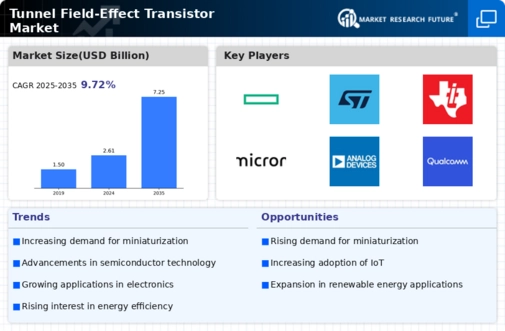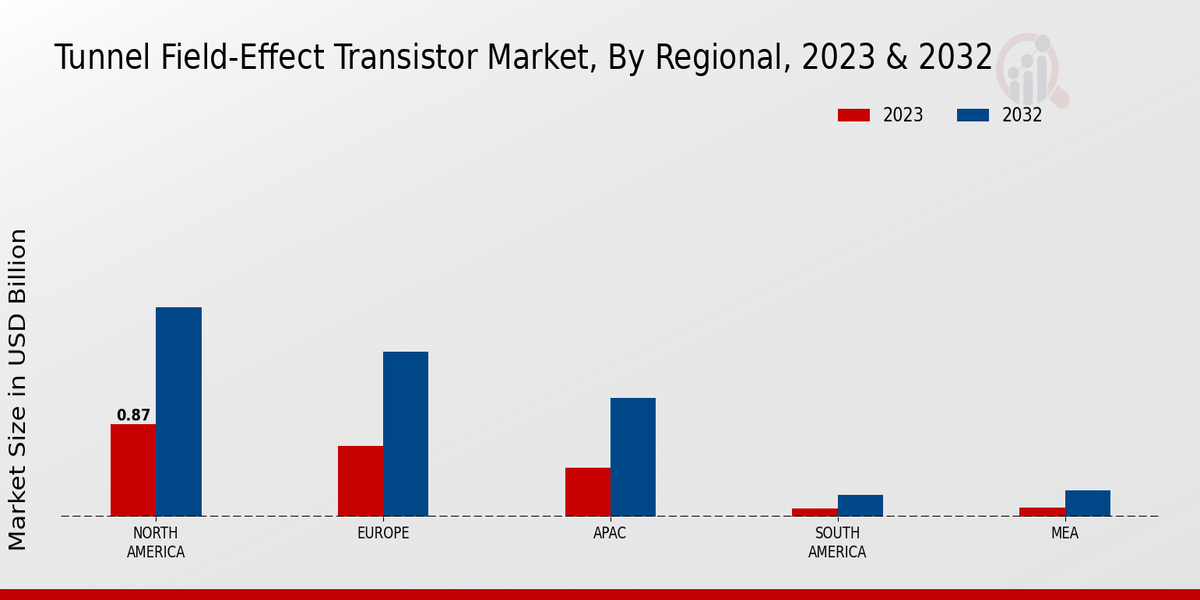Market Growth Projections
The Global Tunnel Field-Effect Transistor Market Industry is projected to experience substantial growth in the coming years. The market is anticipated to reach 2.61 USD Billion in 2024, with expectations of expanding to 7.25 USD Billion by 2035. This growth trajectory indicates a compound annual growth rate of 9.74% from 2025 to 2035. Such projections highlight the increasing adoption of TFET technology across various sectors, driven by advancements in semiconductor manufacturing and the rising demand for energy-efficient electronic components. The market's expansion reflects the broader trends in technology and sustainability, positioning TFETs as a key player in the future of electronics.
Rising Demand for Low-Power Electronics
The Global Tunnel Field-Effect Transistor Market Industry experiences a surge in demand driven by the increasing need for low-power electronic devices. As consumer electronics evolve, manufacturers seek components that enhance energy efficiency without compromising performance. Tunnel Field-Effect Transistors (TFETs) offer a promising solution, as they operate at lower voltage levels, thereby reducing power consumption. This trend is particularly evident in portable devices, where battery life is paramount. The market is projected to reach 2.61 USD Billion in 2024, reflecting the growing adoption of TFETs in various applications, including smartphones and wearables.
Advancements in Semiconductor Technology
Technological advancements in semiconductor manufacturing significantly influence the Global Tunnel Field-Effect Transistor Market Industry. Innovations in fabrication techniques, such as atomic layer deposition and advanced lithography, enable the production of TFETs with improved performance metrics. These advancements facilitate the integration of TFETs into existing semiconductor processes, enhancing their viability for commercial applications. As a result, the market is expected to grow at a compound annual growth rate of 9.74% from 2025 to 2035, potentially reaching 7.25 USD Billion by 2035. This growth underscores the importance of continuous innovation in semiconductor technology to meet the evolving demands of the electronics industry.
Increasing Focus on Sustainable Technologies
The Global Tunnel Field-Effect Transistor Market Industry is significantly impacted by the increasing focus on sustainable technologies. As global awareness of environmental issues rises, industries are compelled to adopt greener alternatives in their manufacturing processes. TFETs, with their lower power consumption and reduced heat generation, align well with sustainability goals. This shift is particularly relevant in sectors such as renewable energy and electric vehicles, where efficiency is crucial. The adoption of TFETs can lead to substantial energy savings, thereby appealing to manufacturers aiming to reduce their carbon footprint and comply with stringent environmental regulations.
Emergence of Internet of Things (IoT) Devices
The emergence of Internet of Things (IoT) devices plays a pivotal role in shaping the Global Tunnel Field-Effect Transistor Market Industry. As IoT applications proliferate, the demand for efficient and compact electronic components rises. TFETs, with their ability to operate at lower power levels, are well-suited for IoT devices that require long battery life and minimal energy consumption. This trend is particularly relevant in smart home technologies and industrial automation, where TFETs can enhance device performance while reducing operational costs. The increasing integration of TFETs in IoT applications is expected to drive market growth significantly.
Growing Applications in RF and Microwave Devices
The Global Tunnel Field-Effect Transistor Market Industry sees a growing application of TFETs in radio frequency (RF) and microwave devices. These components are essential for telecommunications and radar systems, where high-frequency performance is critical. TFETs offer advantages such as higher gain and lower noise figures compared to traditional transistors, making them suitable for these demanding applications. As the demand for faster and more reliable communication systems increases, the integration of TFETs into RF and microwave technologies is likely to expand. This trend may contribute to the overall growth of the market, as industries seek to enhance their communication capabilities.












